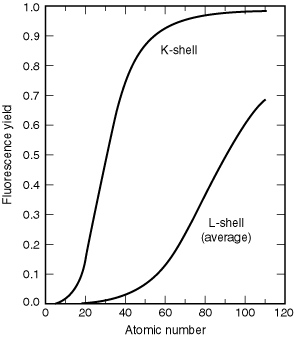X-Ray Data Booklet
Section 1.3 FLUORESCENCE YIELDS FOR K and L SHELLS
Fluorescence yields for the K and L shells for the elements 5 £ Z £ 110 are plotted in Fig. 1-2; the data are based on Ref. 1. These yields represent the probability of a core hole in the K or L shells being filled by a radiative process, in competition with nonradiative processes. Auger processes are the only nonradiative processes competing with fluorescence for the K shell and L3 subshell holes. Auger and Coster-Kronig nonradiative processes complete with fluorescence to fill L1 and L2 subshell holes. Only one curve is presented for the three L subshells, representing the average of the L1, L2, and L3 effective fluorescence yields in Ref. 1, which differ by less than about 10% over most of the periodic table. See Ref. 1 for more detail on the L subshell rates and the nonradiative rates, and for an appendix containing citations to the theoretical and experimental work upon which Fig. 1-2 is based. Widths of K and L fluorescence lines can be found in Ref. 2.
REFERENCES
1. M. O. Krause, “Atomic Radiative and Radiationless Yields for K and L Shells,” J. Phys. Chem. Ref. Data 8, 307 (1979).
2. M. O. Krause and J. H. Oliver, “Natural Widths of Atomic K and L Levels, Ka X-Ray Lines and Several KLL Auger Lines,” J. Phys. Chem. Ref. Data 8, 329 (1979).
